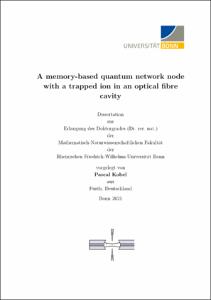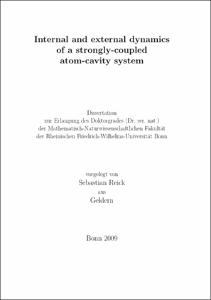Kobel, Pascal: A memory-based quantum network node with a trapped ion in an optical fibre cavity. - Bonn, 2022. - Dissertation, Rheinische Friedrich-Wilhelms-Universität Bonn.
Online-Ausgabe in bonndoc: https://nbn-resolving.org/urn:nbn:de:hbz:5-65559
Online-Ausgabe in bonndoc: https://nbn-resolving.org/urn:nbn:de:hbz:5-65559
@phdthesis{handle:20.500.11811/9873,
urn: https://nbn-resolving.org/urn:nbn:de:hbz:5-65559,
author = {{Pascal Kobel}},
title = {A memory-based quantum network node with a trapped ion in an optical fibre cavity},
school = {Rheinische Friedrich-Wilhelms-Universität Bonn},
year = 2022,
month = jun,
note = {Exploiting quantum effects in the communication between different systems promise great capabilities as distributed quantum computing or provably secure communication. In this thesis we present the realisation of a memory-based quantum network node as a basic building block for quantum communication. The network node comprises of a single trapped ion as a stationary qubit, which is coupled to a light-matter interface linking the ion to a photonic communication channel. We present the application of an optical resonator, which consists of two opposing mirrors that we have realised at the end of two optical fibres. The small resonator volume (mode volume) increases the light-matter interaction rate, allowing a high bandwidth for the distribution of quantum information in a network via optical photons. In addition, the fibre-based resonator provides intrinsic coupling of the photons to optical fibres, which greatly simplifies their distribution in a network.
We demonstrate the first generation of quantum entanglement between a stationary qubit and a photon, with an optical fibre resonator as the interface between both qubits. Since a quantum state cannot be copied and transmitted classically, entanglement is essential for the purpose of quantum communication. We show that even at a distance (about 1.5 m) the ion and the photon share a common entangled quantum state with a high fidelity of (90.1 ± 1.7)%. The entangled state is generated on-demand by the deterministic excitation of the ion, where we achieve a detection rate of 62 Hz, enabled by the efficient interface between ion and photon.
The presented entanglement between an atom and a photon as two different types of qubits allows us to combine the advantages of information storage (atom) and long range distribution of quantum information (photon). In this context, we demonstrate the first implementation of a provably secure quantum key distribution (QKD) between two remote parties involving an entangled memory qubit. The presented method hereby addresses two principal challenges of quantum key distribution, namely key generation and long-range application. We show that the fundamental quantum mechanical properties of the entangled two-qubit state allow us to generate a key with certifiable randomness, which in this strong form is not possible classically. Furthermore, the presented methods of memory-based key distribution are particularly applicable in the context of quantum repeaters, in which quantum information is temporarily stored before further distribution. This enables long-range key distribution even beyond the point-to-point limit of optical quantum communication, which results from the absorption properties of optical photons as information carriers.},
url = {https://hdl.handle.net/20.500.11811/9873}
}
urn: https://nbn-resolving.org/urn:nbn:de:hbz:5-65559,
author = {{Pascal Kobel}},
title = {A memory-based quantum network node with a trapped ion in an optical fibre cavity},
school = {Rheinische Friedrich-Wilhelms-Universität Bonn},
year = 2022,
month = jun,
note = {Exploiting quantum effects in the communication between different systems promise great capabilities as distributed quantum computing or provably secure communication. In this thesis we present the realisation of a memory-based quantum network node as a basic building block for quantum communication. The network node comprises of a single trapped ion as a stationary qubit, which is coupled to a light-matter interface linking the ion to a photonic communication channel. We present the application of an optical resonator, which consists of two opposing mirrors that we have realised at the end of two optical fibres. The small resonator volume (mode volume) increases the light-matter interaction rate, allowing a high bandwidth for the distribution of quantum information in a network via optical photons. In addition, the fibre-based resonator provides intrinsic coupling of the photons to optical fibres, which greatly simplifies their distribution in a network.
We demonstrate the first generation of quantum entanglement between a stationary qubit and a photon, with an optical fibre resonator as the interface between both qubits. Since a quantum state cannot be copied and transmitted classically, entanglement is essential for the purpose of quantum communication. We show that even at a distance (about 1.5 m) the ion and the photon share a common entangled quantum state with a high fidelity of (90.1 ± 1.7)%. The entangled state is generated on-demand by the deterministic excitation of the ion, where we achieve a detection rate of 62 Hz, enabled by the efficient interface between ion and photon.
The presented entanglement between an atom and a photon as two different types of qubits allows us to combine the advantages of information storage (atom) and long range distribution of quantum information (photon). In this context, we demonstrate the first implementation of a provably secure quantum key distribution (QKD) between two remote parties involving an entangled memory qubit. The presented method hereby addresses two principal challenges of quantum key distribution, namely key generation and long-range application. We show that the fundamental quantum mechanical properties of the entangled two-qubit state allow us to generate a key with certifiable randomness, which in this strong form is not possible classically. Furthermore, the presented methods of memory-based key distribution are particularly applicable in the context of quantum repeaters, in which quantum information is temporarily stored before further distribution. This enables long-range key distribution even beyond the point-to-point limit of optical quantum communication, which results from the absorption properties of optical photons as information carriers.},
url = {https://hdl.handle.net/20.500.11811/9873}
}









